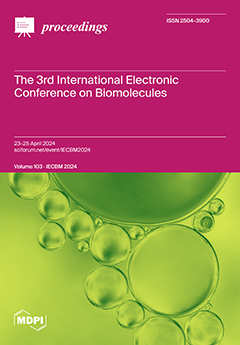Need Help?
Proceedings, 2024, IECBM 2024
The 3rd International Electronic Conference on Biomolecules
Online | 23–25 April 2024
Volume Editor:
Vladimir N. Uversky, University of South Florida, USA
- Issues are regarded as officially published after their release is announced to the table of contents alert mailing list.
- You may sign up for e-mail alerts to receive table of contents of newly released issues.
- PDF is the official format for papers published in both, html and pdf forms. To view the papers in pdf format, click on the "PDF Full-text" link, and use the free Adobe Reader to open them.
Cover Story (view full-size image):
This volume presents a collection of accepted abstracts from the 3rd International Electronic Conference on Biomolecules held on 23–25 April 2024. This virtual conference offers biomolecular
[...] Read more.
This volume presents a collection of accepted abstracts from the 3rd International Electronic Conference on Biomolecules held on 23–25 April 2024. This virtual conference offers biomolecular researchers and scientists a chance to interact, learn from each other, share ideas, solve problems, and suggest alternative solutions. The main topics and sessions of the conference are as follows: biomolecular structures and functions; molecular mechanisms in cellular processes; biomolecular interactions and networks; biomaterials design and characterization; biocatalysis and enzyme engineering; and bioinformatics and computational biology.
Previous Issue
Next Issue
Issue View Metrics
Multiple requests from the same IP address are counted as one view.



